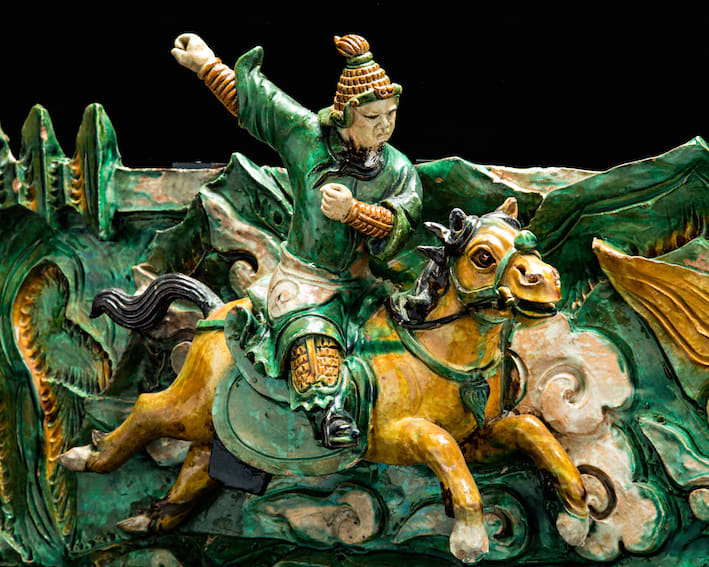Pair of Glazed Ceramic Panels Featuring a Horse Rider Amidst Mountain Peaks, 1368 CE - 1644 CE
Glazed Terracotta
36.2 x 65 cm
14 1/4 x 25 5/8 in
14 1/4 x 25 5/8 in
LA.527
Further images
These remarkable ceramic polychrome panels date from the Ming Dynasty, which ruled China between the mid 14th and mid 17th centuries AD and is widely believed to be one of...
These remarkable ceramic polychrome panels date from the Ming Dynasty, which ruled China between the mid 14th and mid 17th centuries AD and is widely believed to be one of the most definitive and important in China’s long history. They are ultra high-relief pieces, depicting a pair of galloping horsemen against a predominantly green background. They are dressed in warrior’s clothing, and were presumably once part of a larger narrative panel. The pieces are notable for their high colouring and glazed finish.
The Ming Dynasty is remarkable for the peasant uprisings that ushered it in. A peasant named Hong Wu founded the dynasty on the destruction of the Yuan Mongol Empire. His background and the manner in which he seized power made him almost pathologically cautious and even paranoid. His intention, influenced by Confucianism, was to create a bureaucracy-free set of agriculturally-based communities that eschewed commercial trade – which was abhorred by Confucius. Confucian perspectives on the avoidance of military development went unheeded, however. He increased the standing army to over one million, imposed what approximated to martial law on his people and spent a fortune building defences, notably the Great Wall of China. He also founded the Forbidden City, from which he governed China’s burgeoning population of around 200 million.
Arts and sciences flourished in the Ming Dynasty, though this was more to do with the flow of unexpected wealth from agricultural surpluses than any particular enlightenment on the part of Hong Wu or his descendents. Painters proliferated, and were very well-paid for their works; Qiu Ying was once paid 2.8 kg (100 oz) of silver to paint a long scroll. Advances were also made in wood/ivory carving, jade-working, lacquerwork, and duotone (blue-white) ceramic design and decoration. Very strident pieces such as this were made for temples and other public spaces, and illustrated mythological and martial scenes from Chinese history.
These are powerful and impressive pieces of Chinese art.
The Ming Dynasty is remarkable for the peasant uprisings that ushered it in. A peasant named Hong Wu founded the dynasty on the destruction of the Yuan Mongol Empire. His background and the manner in which he seized power made him almost pathologically cautious and even paranoid. His intention, influenced by Confucianism, was to create a bureaucracy-free set of agriculturally-based communities that eschewed commercial trade – which was abhorred by Confucius. Confucian perspectives on the avoidance of military development went unheeded, however. He increased the standing army to over one million, imposed what approximated to martial law on his people and spent a fortune building defences, notably the Great Wall of China. He also founded the Forbidden City, from which he governed China’s burgeoning population of around 200 million.
Arts and sciences flourished in the Ming Dynasty, though this was more to do with the flow of unexpected wealth from agricultural surpluses than any particular enlightenment on the part of Hong Wu or his descendents. Painters proliferated, and were very well-paid for their works; Qiu Ying was once paid 2.8 kg (100 oz) of silver to paint a long scroll. Advances were also made in wood/ivory carving, jade-working, lacquerwork, and duotone (blue-white) ceramic design and decoration. Very strident pieces such as this were made for temples and other public spaces, and illustrated mythological and martial scenes from Chinese history.
These are powerful and impressive pieces of Chinese art.









